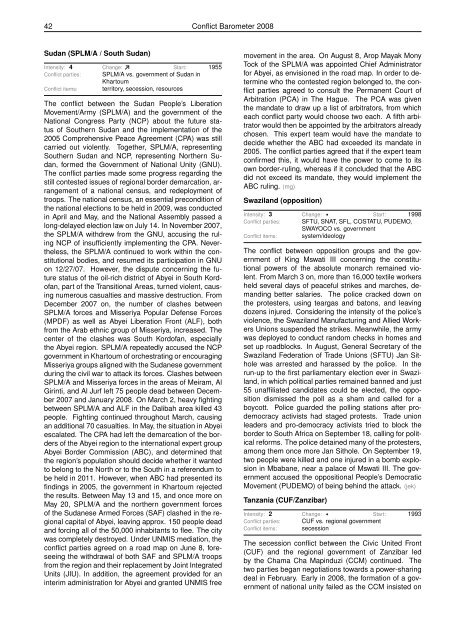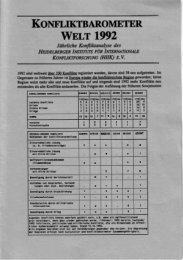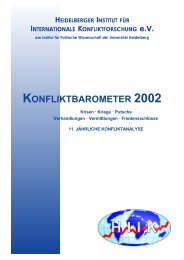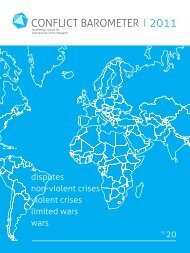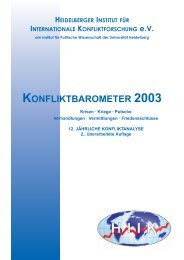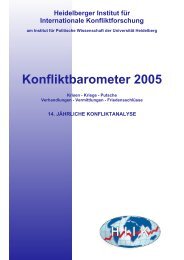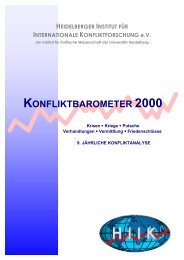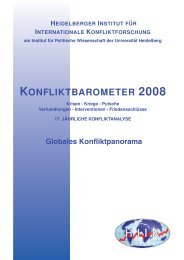CONFLICT BAROMETER 2008
CONFLICT BAROMETER 2008
CONFLICT BAROMETER 2008
You also want an ePaper? Increase the reach of your titles
YUMPU automatically turns print PDFs into web optimized ePapers that Google loves.
42 Conflict Barometer <strong>2008</strong><br />
Sudan (SPLM/A / South Sudan)<br />
Intensity: 4 Change: Start: 1955<br />
Conflict parties: SPLM/A vs. government of Sudan in<br />
Khartoum<br />
Conflict items: territory, secession, resources<br />
The conflict between the Sudan People’s Liberation<br />
Movement/Army (SPLM/A) and the government of the<br />
National Congress Party (NCP) about the future status<br />
of Southern Sudan and the implementation of the<br />
2005 Comprehensive Peace Agreement (CPA) was still<br />
carried out violently. Together, SPLM/A, representing<br />
Southern Sudan and NCP, representing Northern Sudan,<br />
formed the Government of National Unity (GNU).<br />
The conflict parties made some progress regarding the<br />
still contested issues of regional border demarcation, arrangement<br />
of a national census, and redeployment of<br />
troops. The national census, an essential precondition of<br />
the national elections to be held in 2009, was conducted<br />
in April and May, and the National Assembly passed a<br />
long-delayed election law on July 14. In November 2007,<br />
the SPLM/A withdrew from the GNU, accusing the ruling<br />
NCP of insufficiently implementing the CPA. Nevertheless,<br />
the SPLM/A continued to work within the constitutional<br />
bodies, and resumed its participation in GNU<br />
on 12/27/07. However, the dispute concerning the future<br />
status of the oil-rich district of Abyei in South Kordofan,<br />
part of the Transitional Areas, turned violent, causing<br />
numerous casualties and massive destruction. From<br />
December 2007 on, the number of clashes between<br />
SPLM/A forces and Misseriya Popular Defense Forces<br />
(MPDF) as well as Abyei Liberation Front (ALF), both<br />
from the Arab ethnic group of Misseriya, increased. The<br />
center of the clashes was South Kordofan, especially<br />
the Abyei region. SPLM/A repeatedly accused the NCP<br />
government in Khartoum of orchestrating or encouraging<br />
Misseriya groups aligned with the Sudanese government<br />
during the civil war to attack its forces. Clashes between<br />
SPLM/A and Misseriya forces in the areas of Meiram, Al<br />
Girinti, and Al Jurf left 75 people dead between December<br />
2007 and January <strong>2008</strong>. On March 2, heavy fighting<br />
between SPLM/A and ALF in the Dalibah area killed 43<br />
people. Fighting continued throughout March, causing<br />
an additional 70 casualties. In May, the situation in Abyei<br />
escalated. The CPA had left the demarcation of the borders<br />
of the Abyei region to the international expert group<br />
Abyei Border Commission (ABC), and determined that<br />
the region’s population should decide whether it wanted<br />
to belong to the North or to the South in a referendum to<br />
be held in 2011. However, when ABC had presented its<br />
findings in 2005, the government in Khartoum rejected<br />
the results. Between May 13 and 15, and once more on<br />
May 20, SPLM/A and the northern government forces<br />
of the Sudanese Armed Forces (SAF) clashed in the regional<br />
capital of Abyei, leaving approx. 150 people dead<br />
and forcing all of the 50,000 inhabitants to flee. The city<br />
was completely destroyed. Under UNMIS mediation, the<br />
conflict parties agreed on a road map on June 8, foreseeing<br />
the withdrawal of both SAF and SPLM/A troops<br />
from the region and their replacement by Joint Integrated<br />
Units (JIU). In addition, the agreement provided for an<br />
interim administration for Abyei and granted UNMIS free<br />
movement in the area. On August 8, Arop Mayak Mony<br />
Tock of the SPLM/A was appointed Chief Administrator<br />
for Abyei, as envisioned in the road map. In order to determine<br />
who the contested region belonged to, the conflict<br />
parties agreed to consult the Permanent Court of<br />
Arbitration (PCA) in The Hague. The PCA was given<br />
the mandate to draw up a list of arbitrators, from which<br />
each conflict party would choose two each. A fifth arbitrator<br />
would then be appointed by the arbitrators already<br />
chosen. This expert team would have the mandate to<br />
decide whether the ABC had exceeded its mandate in<br />
2005. The conflict parties agreed that if the expert team<br />
confirmed this, it would have the power to come to its<br />
own border-ruling, whereas if it concluded that the ABC<br />
did not exceed its mandate, they would implement the<br />
ABC ruling. (mg)<br />
Swaziland (opposition)<br />
Intensity: 3 Change: Start: 1998<br />
Conflict parties: SFTU, SNAT, SFL, COSTATU, PUDEMO,<br />
SWAYOCO vs. government<br />
Conflict items: system/ideology<br />
The conflict between opposition groups and the government<br />
of King Mswati III concerning the constitutional<br />
powers of the absolute monarch remained violent.<br />
From March 3 on, more than 16,000 textile workers<br />
held several days of peaceful strikes and marches, demanding<br />
better salaries. The police cracked down on<br />
the protesters, using teargas and batons, and leaving<br />
dozens injured. Considering the intensity of the police’s<br />
violence, the Swaziland Manufacturing and Allied Workers<br />
Unions suspended the strikes. Meanwhile, the army<br />
was deployed to conduct random checks in homes and<br />
set up roadblocks. In August, General Secretary of the<br />
Swaziland Federation of Trade Unions (SFTU) Jan Sithole<br />
was arrested and harassed by the police. In the<br />
run-up to the first parliamentary election ever in Swaziland,<br />
in which political parties remained banned and just<br />
55 unaffiliated candidates could be elected, the opposition<br />
dismissed the poll as a sham and called for a<br />
boycott. Police guarded the polling stations after prodemocracy<br />
activists had staged protests. Trade union<br />
leaders and pro-democracy activists tried to block the<br />
border to South Africa on September 18, calling for political<br />
reforms. The police detained many of the protesters,<br />
among them once more Jan Sithole. On September 19,<br />
two people were killed and one injured in a bomb explosion<br />
in Mbabane, near a palace of Mswati III. The government<br />
accused the oppositional People’s Democratic<br />
Movement (PUDEMO) of being behind the attack. (jek)<br />
Tanzania (CUF/Zanzibar)<br />
Intensity: 2 Change: Start: 1993<br />
Conflict parties: CUF vs. regional government<br />
Conflict items: secession<br />
The secession conflict between the Civic United Front<br />
(CUF) and the regional government of Zanzibar led<br />
by the Chama Cha Mapinduzi (CCM) continued. The<br />
two parties began negotiations towards a power-sharing<br />
deal in February. Early in <strong>2008</strong>, the formation of a government<br />
of national unity failed as the CCM insisted on


